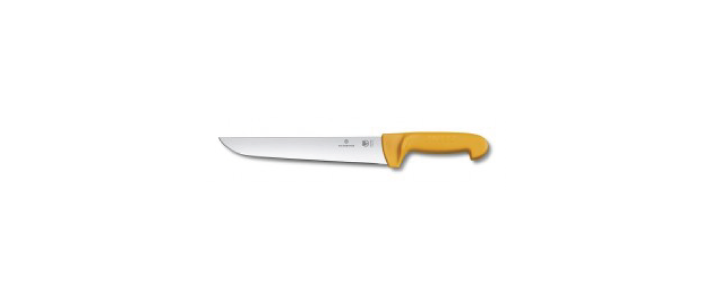An overview of the anatomy of a butcher’s knife
For one of the oldest tools known to man, the modern knife has a surprising level of complexity to its construction. Getting the best results from your knife is all about knowing how to use it properly, and to do that, you’ve got to have a good understanding of its anatomy. Below, we go into a bit of detail about all the various aspects of the modern butcher’s knife, helping you to understand how you can use it most efficiently and effectively.
The blade of your butcher’s knife
Most of the best butcher’s knives have blades which are made of high-carbon stainless steel – as is the case with most of our knives here at Butcher’s Equipment Warehouse. It’s favoured for being a hard metal that keeps its edge for a long time, and won’t discolour. Blades are typically measured in inches (despite our usual preference for the metric system here in Britain). Lengths of between 8” to 12” are the most common.
The tip
In this context, the tip of the blade includes the point, and is considered to be the first third of the edge. Most butchers and chefs use it for slicing and delicate cutting.
The heel
The edge of the butcher’s knife runs all the way from the tip of the blade, down its foremost edge, and down to what we call the heel of the knife – in other words, where it meets the handle. This is the widest part of the knife, and the sturdiest.
As a result, it’s the section of the blade that’s mostly used for chopping hard items like carrots, nuts and chicken bones. Typically, longer blades are known to have greater leverage, which results in more cutting force at the heel of the blade. Handy for (literal) tough nuts to crack!
The spine
Running parallel to the edge along the back of the knife is the ‘spine’ of the blade. This is one of the more intuitively-named segments – after all, spines also run down the backs of humans!
The thickness of the spine on a butcher’s knife will vary between individual knives, and affects the overall strength and stability of the blade.
The bolster
The bolster of the butcher’s knife is the thick shoulder of heavy steel located where the blade’s spine meets the handle. The bolster will be the section that faces up towards you when you’re cutting down. It’s designed to act as a balance on the knife, keeping your fingers from slipping for easier and safer cutting.
It’s worth bearing in mind that not all knives have a bolster, but most of the best butcher’s knives will. Essentially, it indicates that the knife has been forged from a single chunk of steel, rather than stamped from a sheet of metal. This makes for a stronger and more durable blade – and the thicker the bolster, the better!
Getting a grip on the handle
Obviously, the quality of the handle is equally as important as the blade. It needs to be comfortable and ergonomic, not slippery or awkward, or cause you to have to grip excessively hard. Historically, butcher knife handles have been made of wood, but for many reasons, that’s not ideal! To begin with, wood is porous, which makes it an easy home for bacteria, especially in the section where the wood meets the steel. In fact, many kitchens and hospitality venues specifically ban knives for this reason. It doesn’t help that wooden handles have a tendency to warp or crack in dishwashers, too.
For these reasons (and others), the handles of most modern butcher’s knives are made from plastic or rubber handles. Here at Butcher’s Equipment Warehouse, we use polypropylene, known for its ergonomic, comfortable grip.
The rivets
This is a fairly straightforward element of their construction. Rivets are the cylindrical studs, often easily visible dotted along the handle. Their job is to keep the handle securely attached to the tang section of the knife (which we’ll come onto in a moment). Rivets on a well-made butcher’s knife shouldn’t protrude from the handle.
They’re most frequently visible in knives with wooden handles, but don’t assume because you can’t see them, they’re not there! Obviously, one of the most common materials in which you probably won’t find them are in butcher’s knives with stainless steel handles. After all, since these sorts of knives will often be made of one single piece of steel anyway, the purpose of having rivets in the first place will be redundant.
The tang
The best butcher’s knives will have what’s called a full tang. In other words, they’ll be forged from a single piece of steel that runs from the tip of the blade all the way down through the handle (sandwiched between pieces of wood, or encased in sections of polypropylene) right down to the bottom. The section of steel that runs inside the handle is called the tang.
‘Full tang’ is an applicable term only to those knives whose tangs go all the way down to the bottom. Full tang construction typically means better balance and overall quality in the knife. Partial tang, or half tang, are often looked on with some disdain by professional butchers, with many not considering these sorts of knives to be worth using at all. Much like with rivets, though, don’t forget that in knives with synthetic handles (like polypropylene), the tang might not be visible from the outside. It’s always worth checking in advance!
Here at Butcher’s Equipment Warehouse, we pride ourselves on being a one-stop shop for a fantastic range of professional, industry-standard butcher’s equipment, including butcher’s knives from award-winning manufacturers such as Victorinox, Dexter’s and Swibo. We even have our own range of BEW butcher’s knives, which includes more specialised options such as boning knives and steak knives. Feel free to browse them right here on our site, or if you’ve got any questions or you’d like to place an order, don’t hesitate to give us a call on 01254 427 761.




